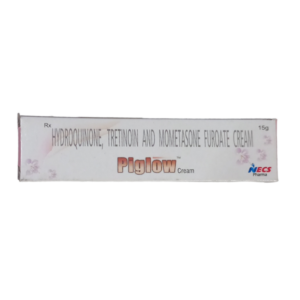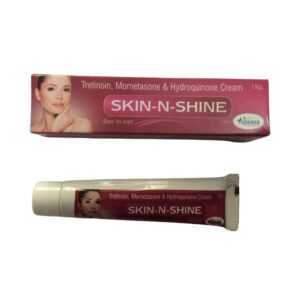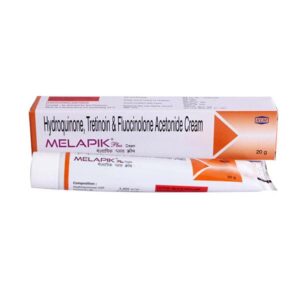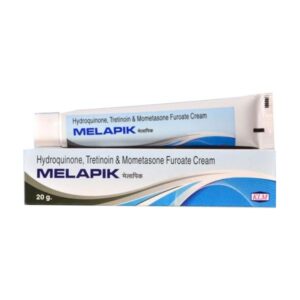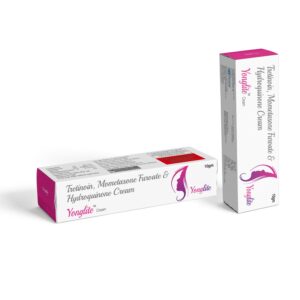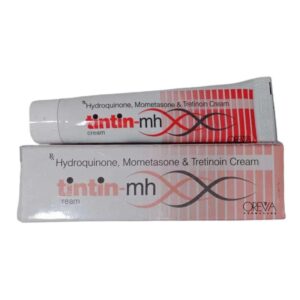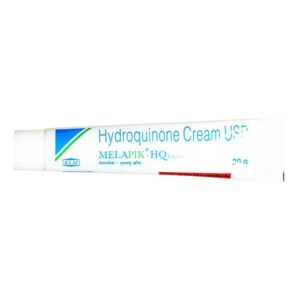TRETINOIN + MOMETASONE + HYDROQUINONE
Tretinoin: Tretinoin is a medication that is derived from Vitamin A and is used primarily as a topical treatment for acne and other skin conditions. It belongs to a class of drugs known as retinoids.
Tretinoin works by speeding up the skin cell turnover process, which helps to unclog pores and prevent the formation of new acne lesions. It also has anti-inflammatory properties, which can reduce redness and swelling associated with acne.
In addition to its use in treating acne, tretinoin is also prescribed to treat fine wrinkles, dark spots, and rough skin caused by sun damage. It can improve the overall texture and appearance of the skin.
Tretinoin is usually applied once daily, in the evening, to clean, dry skin. The exact dosage and duration of treatment depend on the severity of the condition being treated. The medication comes in different strengths, and the healthcare provider will determine the appropriate strength for each individual.
Common side effects of tretinoin include skin irritation, dryness, peeling, and redness. These side effects are usually mild and may improve as the skin gets used to the medication. It is important to avoid excessive sun exposure and use sunscreen while using tretinoin, as it can increase the skin’s sensitivity to sunlight.
In some cases, tretinoin can cause more severe side effects, such as severe burning, blistering, or crusting of the skin. If any of these occur, it is important to seek medical attention.
It is worth noting that tretinoin can cause birth defects if used during pregnancy. Therefore, it is important to use effective contraception while on this medication and avoid becoming pregnant during treatment.
Overall, tretinoin is an effective and widely used medication for the treatment of acne and various skin conditions. However, it is important to use it as directed by a healthcare professional and to be aware of the potential side effects.
Mometasone: Mometasone is a synthetic corticosteroid medication that is primarily used to treat various skin conditions such as eczema, dermatitis, and psoriasis. It is also used in the treatment of allergic rhinitis and asthma.
The mechanism of action of Mometasone involves its ability to bind to specific receptors in the cells. Once bound, it inhibits the production of inflammatory substances, thus reducing inflammation and relieving symptoms associated with various skin conditions.
When used for skin conditions, Mometasone is usually available as a cream, ointment, or lotion. The exact dose and frequency of application can vary depending on the severity of the condition and the individual’s response to the treatment. It is important to follow the instructions provided by the healthcare professional or as indicated on the packaging.
As with any medication, Mometasone can have side effects. Common side effects when used topically include skin irritation, burning, itching, and dryness at the site of application. In rare cases, it may lead to allergic reactions or skin thinning. Prolonged use or excessive application of Mometasone can also lead to systemic side effects such as adrenal suppression, Cushing’s syndrome, and increased susceptibility to infections.
It is crucial to inform your healthcare professional about any existing medical conditions, medications, or allergies before using Mometasone to ensure its safe and effective use. It is also essential to use the medication as directed and avoid prolonged use without medical supervision.
Hydroquinone: Hydroquinone is a medication that is primarily used for skin lightening and treating hyperpigmentation. It is available as a topical cream or gel and works by inhibiting the enzyme tyrosinase, which is involved in the production of melanin, the pigment responsible for the color of the skin.
Hydroquinone is commonly employed to treat conditions such as melasma, freckles, age spots, and post-inflammatory hyperpigmentation. It works by reducing the production of melanin, thereby lightening the skin.
The typical recommended dose of hydroquinone is to apply a thin layer of the cream or gel to the affected area twice daily. It is important to follow the instructions provided by the healthcare professional or as written on the product label.
While hydroquinone is generally safe to use, it may cause certain side effects. Common side effects include mild skin irritation, redness, dryness, peeling, and a temporary darkening of the treated skin. These side effects are typically mild and improve over time as the skin adjusts to the medication.
Rarely, hydroquinone can cause more severe side effects, such as severe skin irritation, allergic reactions, blisters, or dark-blue or black discoloration of the skin. If any of these side effects occur, it is crucial to discontinue use and seek medical attention.
Long-term use of hydroquinone has been associated with a condition called exogenous ochronosis, which causes the skin to turn dark and blue-black. However, this side effect is relatively rare and more commonly occurs with high concentrations of hydroquinone or prolonged use.
It is important to note that hydroquinone should not be used for an extended period without medical supervision, and prolonged use should be avoided. It is also recommended to wear sunscreen and avoid excessive sun exposure while using hydroquinone, as the medication can increase sensitivity to sunlight.
It is advisable to consult a dermatologist before using hydroquinone to determine the appropriate concentration and duration of treatment for individual needs.

